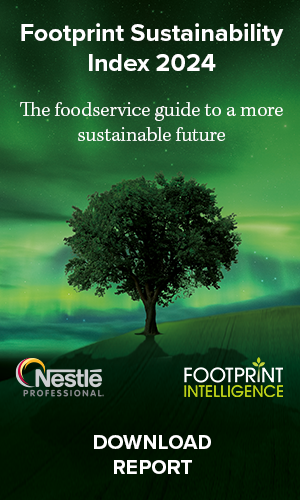As ministers dither over plans to improve food information to consumers, businesses refuse to wait for a harmonised approach, says Nick Hughes.
Devising the metrics that underpin an environmental score for food products is a notoriously difficult task, although not nearly as difficult as trying to make sense of the government’s current food labelling policy.
I jest of course (sort of), but it certainly takes a quizzical mind to keep pace with the plethora of announcements and consultations – both pending and completed – that are intended to set new standards for the how information concerning the welfare and environmental impact of food products is presented to the end consumer both in and out of the home.
In January, Defra secretary of state Steve Barclay announced a new “rapid consultation” on clearer labelling “to tackle the unfairness created by misleading labelling and protect farmers and consumers”. He stated that the consultation (not so rapid that it has already been launched) would explore how to better highlight imports that do not meet UK welfare standards and whether existing country of origin labelling rules can be strengthened by mandating how and where origin information is displayed, thereby addressing long-held concerns that animals reared to lower welfare standards overseas can be processed in the UK and presented to consumers as British.
Was this the long-awaited consultation on improving and expanding current mandatory labelling requirements for animal welfare that was promised in the government’s response to an original call for evidence on labelling for animal welfare published back in August 2022?
The tentative answer is yes, according to an enquiry lodged with Defra’s press office. I say tentative because while the response referenced both consultations in the context of government plans to stimulate market demand for higher welfare products, it stopped short of explicitly connecting one consultation with the other.
According to one NGO that contributed to the original call for evidence, the new “rapid” consultation is in effect going to be an expansion of the first one with environmental standards included as well as a greater focus on imported products (timely given last week’s protests at the Port of Dover by angry farmers).
Positive outlook
Despite the confusion, stakeholders are by and large encouraged by the mere fact that ministers are talking the language of better information to consumers. “Clearer labelling on food imported from abroad, and especially those that don’t meet our UK welfare standards, could be a lifeline to British farmers who are at risk of being undercut by cheap, low welfare imports flooding our shelves through free trade agreements,” said David Bowles, head of public affairs at the RSPCA.
The new consultation was also welcomed by the Clear food label consortium. Consisting of over 40 farming, food and civil society organisations and businesses, Clear champions the importance of regulating food labelling information. “The government needs to ensure that primary method-of-production data, from pre-farm to on-farm to processing and manufacturing, that shows the reality of UK food production, underpins all environmental and social food labelling,” said its chair Fidelity Weston.
Eco-labels
Clear has been a vocal critic of the growing wave of eco-labels that largely rely on the use of secondary data that is representative of, rather than specific to, commodity supply chains. Indeed, the debate over data integrity continues to dominate discourse surrounding eco-labels.
To be clear, Barclay’s rapid consultation on clearer labelling is not the same as a planned government consultation on environmental labelling expected at some point later this year. This relates to a pledge made in the 2022 government food strategy to develop a mandatory methodology for voluntary eco-labelling of food and drink to bring about standardisation of existing and emerging schemes. The work is being led by the government’s food data transparency partnership (FDTP) eco working group, which aims to develop proposals and publish a first set of outputs in 2024.
IGD has emerged as a frontrunner in the race to become the go-to standard for eco-labels amid a huge proliferation of different schemes. In December, the grocery industry organisation published a 204-page ‘summary’ of evidence and recommendations to date on its proposal for a harmonised approach to environmental labelling for the UK. Backed by some heavyweight businesses including Tesco, Asda, Nestlé and PepsiCo, IGD said that without a coordinated approach from the whole UK food sector “we risk confusing businesses and adding complexity and cost to businesses and supply chains”.
IGD recommends using a lifecycle assessment-(LCA) based approach covering climate change, water use, water quality and land use impacts, communicated with a consumer-facing label that should include an A-E scale combined with a red, amber and green display. Recognising the push for supply chain specific data from Clear and other producer groups, IGD plans to develop a database combining secondary data with primary data, where the latter is available, that is continually updated and improved. For its part, Defra says it will consider IGD’s report alongside other research as it continues to develop its own policy.
Other scheme owners seem unlikely to row in behind the IGD’s ‘harmonised’ approach. There are estimated to be at least 350 different eco-labels to have emerged globally, with some food businesses lending their support to multiple schemes at the same time. One of the biggest rivals to the IGD is the Eco Impact scheme run by Foundation Earth. The Grocer recently reported that there has been no contact between the two organisations for months as Foundation Earth continues to push for a universal system rather than the UK-specific one promoted by IGD.
In the meantime, the rollout of carbon and eco-labels by businesses continues at pace, supported by a plethora of technology start-ups that supply them with automated impact data. In January, for example, the event caterer Freemans Event Partners announced it had struck a deal with Klimato to allow carbon labelling information to be placed on menus at venues including Wembley Stadium, Lord’s Cricket Ground and Twickenham Stadium.
Do labels matter?
Amid the race to communicate transparent environmental data to consumers, there has been little reflection on whether the data being provided will actually shift purchasing behaviours. Some foodservice and hospitality businesses have had encouraging results – Hilton is expanding its menu labels following a successful trial that shifted behaviour to lower emission dishes, for example, while there is academic research also showing the potential of the labels. Design has, however, been a sticking point.
Other evidence has been less favourable. Last year, the Food Standards Agency carried out research into the impact food labelling has on consumer decision-making. The answer, it concluded, is very little. In both laboratory and field studies the research found that the role food labels play in influencing people’s choices is limited. This is partly because people are trading off all other information on food products against price, value for money, and quality, which are consistently revealed as the most salient information that impacts consumer food choices.
The research concluded that “any effort to promote healthy, safe and sustainable diets requires acceptance of the limitations of food labelling to substantively perform a behavioural change function”. Or to put it more cynically, the huge effort being devoted to developing better labelling solutions and policies could ultimately be for little reward.














